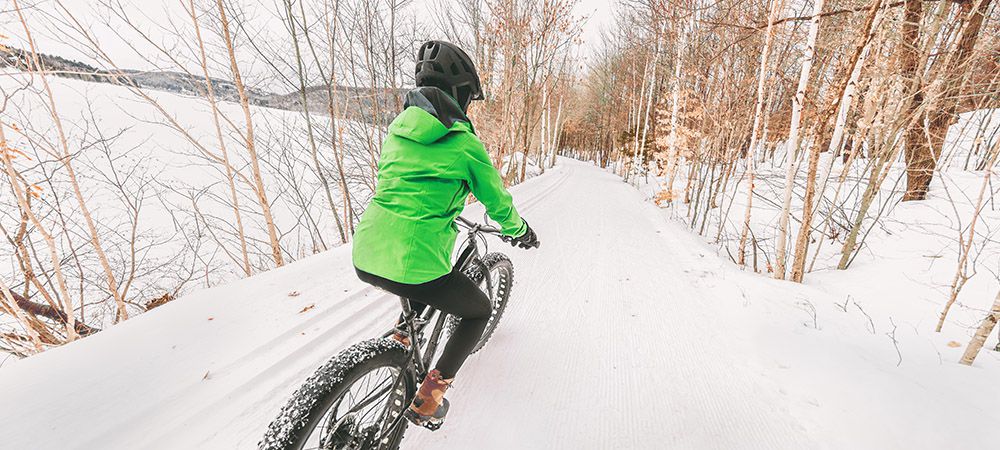Cycling can be hazardous at the best of times but in the winter, you need to be hyper-aware of your surroundings. This is due to two factors that increase the danger level: the freezing temperatures and the lack of sunlight.
That’s why we wanted to give you some winter riding tips which are going to keep you going when those colder days come. These tips will allow you to stay fit and keep you doing the thing you love. Let’s start with one of the most obvious tips of all.
Put on Extra Layers
While dressing before cycling, always think about your head, hands, torso, and feet. As most of the body heat escapes from our head, it needs to be your top priority. This can be solved by using a balaclava under your helmet, this tip is considered to be the best to keep you warm and composed. If you don’t want to wear a balaclava then you should wear a cycling cap at a minimum.
Cover your hands with either mittens or long-fingered gloves. It would be a wise decision to choose full-length gloves as they are not only going to give protection from the cold but also a better feel on your handlebars, and when applying the brakes.
When cycling, our feet rarely touch the ground but they can still get very cold. To keep your feet warm, you should put on two pairs of socks and consider covering your shoes with thermal shoe covers. Thermal shoe covers cut away the wind entering your feet and keep your feet warm.
After keeping your head, hands and feet warm now it’s your turn to keep your torso warm. For this, adding extra layers will be all you need. Put on an insulating base layer like woolen sweaters to lock the heat in. Don’t forget to put on an outer layer of a wind and waterproof jacket. Use windproof pants and leg warmers to protect your knees.
The exact number of layers you need is going to depend on the exact temperature and wind speed. It’s best to be over prepared as you can always take extra layers off if you’re too warm.
Research Your Route Before Hitting the Road
No matter whether it is a solo ride or with mates, whether it is a famous sporting route or a quick ride to the shop, it is essential to do some research about that route in advance.
The planning and research help to make your ride smooth. It is winter, and debris on the road is more common. Plus, snowflakes may result in slippery roads and any water may freeze. That’s why doing some research about whether the route is clear or not becomes most essential in winter.
When planning your route in winter, it makes sense to go for the easiest route and not always the quickest. It’s best to avoid any pathways that may be particularly hazardous and it’s best to stick to well-lit areas.
If you know the area, you’ll have a good idea of which routes should be avoided. If you don’t, then it’s best to stick to a simple route and ideally one that stays close to residential areas.
In Toronto, there are maps that allow you to see their snow routes and which roads have been cleared. This means you can check it before you head out and have confidence that the path will be snow-free. If they aren’t clear, then you can get in touch with them to get the plowers out.
The roads get cleared fairly quickly but if there has recently been a lot of snow, then this map can give you the reassurance that you’ll still be able to get out there on your bike. It’s always a good idea to have a quick check of the snow routes on your phone before you head out.
Prepare Your Bike for Winter Riding
After every ride, particularly during winter, it is vital to clean and lube your bicycle. This is especially important in winter as there is a high chance of causing damage in your drivetrain by salty road spray.
It’s also a good idea to fit wider mudguards, and swap your tires for wider and puncture resistance models. Roads are slippery in winter due to melting snow or dew so choose wider and grippy tires. Those thin road tires which give you low rolling resistance in the summer simply aren’t going to be good enough.
A decent-sized waterproof saddle bag or backpack can be your best friend too. This allows you to carry any repair gear you need along with spare clothing or even a first aid kit. You need to be prepared if your bike breaks down or you have an accident.
Check each and every cable on your bicycle periodically. It will be great if you upgrade your braking and gear system with thick and waterproof cables. During winter your drivetrain becomes dry, affecting your ride. So don’t forget to lubricate the chain, chainset, cassette, front and rear derailleurs, gears, and braking system time and again.
While you can’t be expected to do a full maintenance check of your bike every day, it’s good to give it a quick glance before every ride to check the gears are engaging properly, the lights still work, there is no issue with the tires and the brakes are still sharp.
Be Visible To Others
Winter days are darker and foggy making it hard for drivers and other riders to notice you unless you take the right steps. So being visible while cycling is the top concern of cyclists. You can be visible by wearing a bright fluorescent color jacket.
As yellow color can be viewed from a great distance in the dark, most cyclists choose neon yellow over others as it becomes an issue of safety over style. Bright orange, hot pink, and lime green are also considered to be highly visible but not quite as much as yellow. You can take it a step further and use reflectors on your jacket too.
Apart from making yourself visible, you can also make your bike stand out by using reflectors or reflective stickers. You can also put reflectors on your wrist, ankles, or knees. You can also put reflective stickers on your clothes mainly on your back so that you can be seen from behind.
Proper lighting is required by the law. You must have a clear headlight and a red tail light. You can set this up to flash while you are riding on a foggy day or in the dark. You might add a flashing LED light on your helmet so you will be noticed more quickly.
Follow the traffic rules strictly while riding not only because it’s the right thing to do but also you need to be exactly where vehicles expect you to be. Doing things like going through a red light can be especially dangerous in the winter.
Don’t Stop for Long and Avoid the Road Verge
It is well-known that winter days are darker and shorter. It’s a good idea to reduce your break and not spend too much time staying still. Long breaks not only cause time loss but also energy loss.
With dropping energy, it makes getting back on your bike even tougher. There will be other factors too such as your fingers getting stiffer which can make it harder to brake effectively.
Avoid the road verge when stopping and put yourself in a safe position. You should be careful where to stop as next to a road in dark and cold conditions isn’t going to be ideal. Find a safe place to stop and don’t stay there long.
If you know that you’re going to take a break, then taking a hot drink with you can be a good idea. You can also take other steps such as hand warmers so your fingers don’t stiffen up.
You should also limit the reasons that you need to stop. For example, if you plan your route carefully before you start riding then you won’t need to check the Sat Nav on your phone. If you need navigation, then invest in a phone holder so you don’t need to constantly take it out of your pocket.
Ride Carefully
The title of this section is ‘ride carefully’ but what exactly does this mean? The biggest potential issue that you’ll have is with turning. In the summer, a bike can take turns quickly and you’ll also be able to lean into it.
In the winter, you won’t want to do any of those things. Take turns slowly and try to stay as upright as possible. Don’t be reluctant to step off your bike and walk over a tricky section of path if you need to.
You also don’t want to pedal through a corner either. If you press down hard on your pedal then there’s a chance your rear wheel can slip and lose grip. If you’re traveling though low-grip areas, always stay as straight as you possibly can.
Avoiding distractions is also important. Don’t be tempted to answer a phone, mess around with a pocket or change your music while on the move. If you need to do any actions like this, pull over safely. In the winter, you need to be alert at all times.
Final Thoughts
Most of these tips are common sense but they can be easy to forget. Many people love cycling and don’t want winter to stop them. If that sounds like you then follow these tips to make sure that you’re staying safe out there.




















